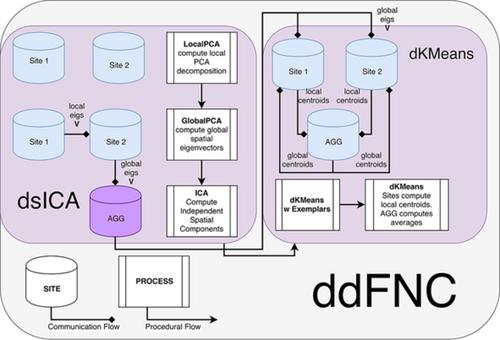当前位置:
X-MOL 学术
›
Hum. Brain Mapp.
›
论文详情
Our official English website, www.x-mol.net, welcomes your
feedback! (Note: you will need to create a separate account there.)
Decentralized dynamic functional network connectivity: State analysis in collaborative settings.
Human Brain Mapping ( IF 3.5 ) Pub Date : 2020-04-21 , DOI: 10.1002/hbm.24986 Bradley T Baker 1, 2, 3 , Eswar Damaraju 1, 2, 3 , Rogers F Silva 1, 2 , Sergey M Plis 1, 2, 3 , Vince D Calhoun 1, 2, 3
Human Brain Mapping ( IF 3.5 ) Pub Date : 2020-04-21 , DOI: 10.1002/hbm.24986 Bradley T Baker 1, 2, 3 , Eswar Damaraju 1, 2, 3 , Rogers F Silva 1, 2 , Sergey M Plis 1, 2, 3 , Vince D Calhoun 1, 2, 3
Affiliation

|
As neuroimaging data increase in complexity and related analytical problems follow suite, more researchers are drawn to collaborative frameworks that leverage data sets from multiple data‐collection sites to balance out the complexity with an increased sample size. Although centralized data‐collection approaches have dominated the collaborative scene, a number of decentralized approaches—those that avoid gathering data at a shared central store—have grown in popularity. We expect the prevalence of decentralized approaches to continue as privacy risks and communication overhead become increasingly important for researchers. In this article, we develop, implement and evaluate a decentralized version of one such widely used tool: dynamic functional network connectivity. Our resulting algorithm, decentralized dynamic functional network connectivity (ddFNC), synthesizes a new, decentralized group independent component analysis algorithm (dgICA) with algorithms for decentralized k ‐means clustering. We compare both individual decentralized components and the full resulting decentralized analysis pipeline against centralized counterparts on the same data, and show that both provide comparable performance. Additionally, we perform several experiments which evaluate the communication overhead and convergence behavior of various decentralization strategies and decentralized clustering algorithms. Our analysis indicates that ddFNC is a fine candidate for facilitating decentralized collaboration between neuroimaging researchers, and stands ready for the inclusion of privacy‐enabling modifications, such as differential privacy.
中文翻译:

分散的动态功能网络连接:协作环境中的状态分析。
随着神经影像数据复杂性的增加以及相关分析问题的随之而来,越来越多的研究人员被协作框架所吸引,这些框架利用来自多个数据收集站点的数据集来平衡复杂性与增加的样本量。尽管集中式数据收集方法在协作场景中占据主导地位,但许多分散式方法(避免在共享中央存储中收集数据的方法)已经越来越受欢迎。随着隐私风险和通信开销对研究人员变得越来越重要,我们预计去中心化方法将继续流行。在本文中,我们开发、实现和评估了一种广泛使用的工具的去中心化版本:动态功能网络连接。我们的结果算法,去中心化动态功能网络连接(ddFNC),综合了一种新的去中心化组独立分量分析算法(dgICA)和去中心化k均值聚类算法。我们将单个去中心化组件和完整的去中心化分析管道与相同数据上的集中式对应组件进行比较,并表明两者都提供了可比较的性能。此外,我们还进行了一些实验,评估各种去中心化策略和去中心化聚类算法的通信开销和收敛行为。我们的分析表明,ddFNC 是促进神经影像研究人员之间去中心化协作的良好候选者,并且已准备好纳入支持隐私的修改,例如差异隐私。
更新日期:2020-04-21
中文翻译:

分散的动态功能网络连接:协作环境中的状态分析。
随着神经影像数据复杂性的增加以及相关分析问题的随之而来,越来越多的研究人员被协作框架所吸引,这些框架利用来自多个数据收集站点的数据集来平衡复杂性与增加的样本量。尽管集中式数据收集方法在协作场景中占据主导地位,但许多分散式方法(避免在共享中央存储中收集数据的方法)已经越来越受欢迎。随着隐私风险和通信开销对研究人员变得越来越重要,我们预计去中心化方法将继续流行。在本文中,我们开发、实现和评估了一种广泛使用的工具的去中心化版本:动态功能网络连接。我们的结果算法,去中心化动态功能网络连接(ddFNC),综合了一种新的去中心化组独立分量分析算法(dgICA)和去中心化k均值聚类算法。我们将单个去中心化组件和完整的去中心化分析管道与相同数据上的集中式对应组件进行比较,并表明两者都提供了可比较的性能。此外,我们还进行了一些实验,评估各种去中心化策略和去中心化聚类算法的通信开销和收敛行为。我们的分析表明,ddFNC 是促进神经影像研究人员之间去中心化协作的良好候选者,并且已准备好纳入支持隐私的修改,例如差异隐私。











































 京公网安备 11010802027423号
京公网安备 11010802027423号